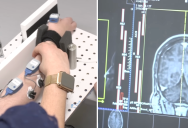Paralyzed Man Says AI Brain Chips Supercharges His Spinal Cord And Allows Him To Feel Sensation Again
by Trisha Leigh

With all of the medical and scientific advancements in the past 50 years, there hasn’t been much in the way of helping people who have spinal injuries that have resulted in paralyzation.
AI says hold their beer, because some think it’s going to be the thing that changes life for paralyzed people around the world.
Keith Thomas is a 45-year-old man who was paralyzed when he dove into the shallow end of a pool on Long Island, NY. This was the summer of 2020 and Thomas has been unable to move or feel his limbs ever since.

At least, that was the case until participation in a recent clinical trial led to his regaining feeling in his arms and hands for the first time in over three years.
The trial procedure is called a double neural bypass, a new bioelectrical therapy born at Northwell Health’s Feinstein Institutes for Medical Research.
The research was led by professor Chad Bouton, and involves a combination of AI, brain-computer interface implants (BCI), external computers, and non-invasive wearable tech.
The neural bypass uses a combination of machine learning and electrical signaling to change the course of a person’s neural signals so that it goes around the barrier preventing their connection.

In Keith’s case, around the break in connected spinal column to allow the sensation of movement and touch.
Bouton says the goal is to finally answer the question of how we could restore broken communication between the brain and the body.
“It’s a very challenging problem. You’re looking at these complex electrical patterns in the brain, and you’re trying to make sense out of the patterns and extract information from them. We want to know when someone’s thinking and moving their hand, or moving their fingers, and we want to be able to then channel those thoughts into something useful.”
They’re using chips embedded in a person’s brain that can learn to interpret neuron language – and it’s showing real promise.
They first performed a neural bypass surgery back in 2016, a procedure that restored movement in the arms of the patient. It did not, however, restore their sense of feeling.
Seven years later, scientists are confident they can do both.
Thomas was the patient, and he spent months staring at simulated arm and hand movements on a computer screen while doctors and engineers studied MRIs of his brain trying to force his arm to move. They used them to map the areas responsible for movement and touch, then decided they would need to implant 5 BCI chips.

Two would go in the area of the brain that worked movement and three would be implanted in the region responsible for touch and feeling in the fingers.
Those chips passed decoded bioelectrical messages to the attached computer, which in turn sent electric signals to the electrode patches on Thomas’ spine and forearms.
He would also have a bunch of tiny sensors on Thomas’ fingertips and palms to send data back to the sensory region of Thomas’ brain.
“Every time he thinks about moving and feeling, we actually send another signal to the spinal cord, and that supercharges the spinal cord. It tries to strengthen connections.”
Thomas had to go through 15 hours of open-brain surgery to have the chips implanted, and not only that, he was awake for most of the procedure, too. He had to relay the sensations he felt to the doctors working on him.
It all went off without a hitch and afterward, Thomas was able to hold his sister’s hand for the first time in 3 years.
In the four months since, Thomas regained full strength in both arms and has even experienced “natural recovery” in his forearm and wrist – which means the implants might have encouraged his nervous system to heal on its own.
“Only several months into the study, he’s making huge gains, doubling his arm strength, and starting to feel new sensations in his forearm and even wrist even after he goes home outside the lab, eve when we turn the computer off.”

Other experts in the field, like Dr. Wilson Zachary Ray, are extremely happy with these results.
“I suspect this sort of AI and ML innovation will see a massive growth in clinical applications over the next 3 to 5 years. At some point in the not too distant future, implantable ‘smart technology’ will be integrated into the fabric of our daily life, similar to how we all view our smartphones today.”
There is still a lot of room for improvement, particularly in the size and bulk of the equipment needed to encourage movement.
“It’s kind of like the early heart and lung machine. We’ve got some parts that are in the body, some parts that are on the laboratory table, and some wearables.”
Over time, they hope to reduce all of that to make it more portable.
Change is not going to happen overnight, but for patients like Thomas, all of the work and sacrifice has been worth it.
I imagine it would be the same for others in his shoes, so hopefully the future will hold more of the predicted success.
Categories: SCI/TECH
Tags: · ai, artificial intelligence, bioelectrical therapy, brain, Chad Bouton, double neural bypass, Northwell Health's Feinstein Institutes, science, single topic, top
Trending on TwistedSifter

Parents Emotionally Manipulated Grandparent Into Babysitting For 5 Days, So They Took The Kids To Disney Without The Parents



